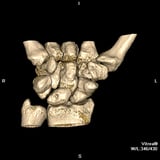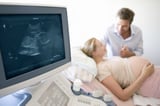Extreme Pain That Goes From Diaphragm Through to Back
Abdominal pain is common and often minor. Severe abdominal pain that comes on quickly, however, almost always indicates a significant problem. The pain may be the only sign of the need for surgery and must be attended to swiftly. Older adults and those who have HIV infection or who are taking immunosuppressants (including corticosteroids) may have less abdominal pain than younger/healthy adults with a similar disorder, and, even if the condition is serious, the pain may develop more gradually. Young children, especially newborns and infants, may develop abdominal pain but are unable to communicate the reason for their distress.
There are different types of abdominal pain depending on the structures involved.
Visceral pain comes from the organs within the abdominal cavity (which are called the viscera). The viscera's nerves do not respond to cutting, tearing, or inflammation. Instead, the nerves respond to the organ being stretched (as when the intestine is expanded by gas) or surrounding muscles contract. Visceral pain is typically vague, dull, and nauseating. It may be hard to pinpoint. Upper abdominal pain results from disorders in organs such as the stomach, duodenum, liver, and pancreas. Midabdominal pain (near the navel) results from disorders of structures such as the small intestine, upper part of the colon, and appendix. Lower abdominal pain results from disorders of the lower part of the colon and organs in the genitourinary tract.
Somatic pain comes from the membrane (peritoneum) that lines the abdominal cavity (peritoneal cavity). Unlike nerves in the visceral organs, nerves in the peritoneum respond to cutting and irritation (such as from blood, infection, chemicals, or inflammation). Somatic pain is sharp and fairly easy to pinpoint.
What Is Referred Pain?
Pain felt in one area of the body does not always represent where the problem is because the pain may be referred there from another area. For example, pain produced by a heart attack may feel as if it is coming from the arm because sensory information from the heart and the arm converge on the same nerve pathways in the spinal cord.
Once peritonitis has been present for a number of hours, the inflammation causes fluid to leak into the abdominal cavity. The person may then develop dehydration and go into shock. Inflammatory substances released into the bloodstream may affect various organs, causing severe lung inflammation, kidney failure, liver failure, and other problems. Without successful treatment, people may die.
Pain can arise from many causes, including infection, inflammation, ulcers, perforation or rupture of organs, muscle contractions that are uncoordinated or blocked by an obstruction, and blockage of blood flow to organs.
Immediately life-threatening disorders, which require rapid diagnosis and surgery, include
-
Ruptured abdominal aortic aneurysm
-
Perforated stomach or intestine
-
Blockage of blood flow to the intestine (mesenteric ischemia)
Serious disorders that are nearly as urgent include
Sometimes, disorders outside the abdomen cause abdominal pain. Examples include heart attack, pneumonia, and twisting of a testis (testicular torsion). Less common problems outside the abdomen that cause abdominal pain include diabetic ketoacidosis, porphyria, sickle cell disease, and certain bites and poisons (such as a black widow spider bite, heavy metal or methanol poisoning, and some scorpion stings).
Abdominal pain in newborns, infants, and young children has numerous causes not encountered in adults ( ).
![]()
The following information can help people decide when a doctor's evaluation is needed and help them know what to expect during the evaluation.
In people with acute abdominal pain, certain symptoms and characteristics are cause for concern. They include
-
Severe pain
-
Signs of shock (for example, a rapid heart rate, low blood pressure, sweating, and confusion)
-
Signs of peritonitis (for example, constant pain that doubles the person over and/or pain that worsens with gentle touching or with bumping the bed)
-
Swelling of the abdomen
People who have warning signs should go to the hospital right away. People who have no warning signs should see a doctor within a day.
Doctors ask questions about the person's symptoms and medical history and do a physical examination. What doctors find during the history and physical examination helps them decide what, if any, tests need to be done. Doctors follow the same process whether they are evaluating mild or severe pain, although a surgeon may be involved early on in the evaluation of severe abdominal pain.
When taking the medical history (see Table: History in People With Acute Abdominal Pain History in People With Acute Abdominal Pain Abdominal pain is common and often minor. Severe abdominal pain that comes on quickly, however, almost always indicates a significant problem. The pain may be the only sign of the need for surgery... read more ), doctors ask questions about the pain's location (see Figure: Causes of Abdominal Pain by Location Causes of Abdominal Pain by Location Abdominal pain is common and often minor. Severe abdominal pain that comes on quickly, however, almost always indicates a significant problem. The pain may be the only sign of the need for surgery... read more ) and characteristics, whether the person has had similar symptoms in the past, and what other symptoms the person has along with the abdominal pain. Symptoms such as heartburn, nausea, vomiting, diarrhea, constipation, jaundice, blood in the stool or urine, coughing up blood, and weight loss help guide the doctor's evaluation. Doctors ask questions about drugs taken, including prescription and illicit drugs as well as alcohol.
Doctors ask questions about known medical conditions and previous abdominal surgeries. Women are asked whether they are or could be pregnant.
When conducting a physical examination, doctors first note the person's general appearance. A comfortable-appearing person rarely has a serious problem, unlike one who is anxious, pale, sweating, or in obvious pain. The focus of the examination is the abdomen, and doctors inspect, tap, and touch (a process called palpation) the abdominal area. They usually examine the rectum and pelvis (for women) to locate tenderness, masses, and blood.
Doctors touch the whole abdomen gently to detect areas of particular tenderness, as well as the presence of guarding, rigidity, rebound, and any masses. Guarding is when a person involuntarily contracts the abdominal muscles when the doctor touches the abdomen. Rigidity is when the abdominal muscles stay firmly contracted even when the doctor is not touching them. Rebound is when a person flinches in pain as the doctor's hand is briskly withdrawn. Guarding, rigidity, and rebound are signs of peritonitis.
![]()
Causes of Abdominal Pain by Location
Sometimes, people have findings so significant that doctors realize right away that they need surgery. Doctors try not to delay surgery on such people by doing tests. However, more often, doctors must do tests to help choose among several different causes suggested by the person's symptoms and physical examination results. Doctors select tests based on what they suspect:
-
Urine pregnancy test for all girls and women of childbearing age
-
Imaging tests based on suspected diagnosis
An abdominal computed tomography (CT) scan Computed Tomography (CT) In computed tomography (CT), which used to be called computed axial tomography (CAT), an x-ray source and x-ray detector rotate around a person. In modern scanners, the x-ray detector usually... read more  helps identify many, but not all, causes of abdominal pain. Urine tests (for example, urinalysis Urinalysis and Urine Culture Urinalysis, the testing of urine, may be necessary in the evaluation of kidney and urinary tract disorders and can also help evaluate bodywide disorders such as diabetes or liver problems. A... read more
helps identify many, but not all, causes of abdominal pain. Urine tests (for example, urinalysis Urinalysis and Urine Culture Urinalysis, the testing of urine, may be necessary in the evaluation of kidney and urinary tract disorders and can also help evaluate bodywide disorders such as diabetes or liver problems. A... read more  ) are frequently done to look for signs of a urinary tract infection or a kidney stone. Blood tests are often done but rarely identify a specific cause (although blood tests can be used to diagnose pancreatitis). An ultrasound Ultrasonography Ultrasonography uses high-frequency sound (ultrasound) waves to produce images of internal organs and other tissues. A device called a transducer converts electrical current into sound waves... read more
) are frequently done to look for signs of a urinary tract infection or a kidney stone. Blood tests are often done but rarely identify a specific cause (although blood tests can be used to diagnose pancreatitis). An ultrasound Ultrasonography Ultrasonography uses high-frequency sound (ultrasound) waves to produce images of internal organs and other tissues. A device called a transducer converts electrical current into sound waves... read more  is helpful if doctors suspect a gallbladder or gynecologic disorder. An endoscopic evaluation, using cameras to look inside the gastrointestinal tract, may be needed.
is helpful if doctors suspect a gallbladder or gynecologic disorder. An endoscopic evaluation, using cameras to look inside the gastrointestinal tract, may be needed.
The specific cause of the pain is treated. Until recently, doctors thought that it was not wise to give pain relievers to people with severe abdominal pain until a diagnosis was made because the pain reliever might mask important symptoms. However, pain relievers are now sometimes given, usually in low doses, while tests are in progress.
-
Doctors look first for any life-threatening causes for the pain.
-
Doctors rule out pregnancy in girls and women of childbearing age.
-
Blood tests rarely identify a specific cause of acute abdominal pain.
Extreme Pain That Goes From Diaphragm Through to Back
Source: https://www.msdmanuals.com/home/digestive-disorders/symptoms-of-digestive-disorders/acute-abdominal-pain
0 Response to "Extreme Pain That Goes From Diaphragm Through to Back"
Post a Comment